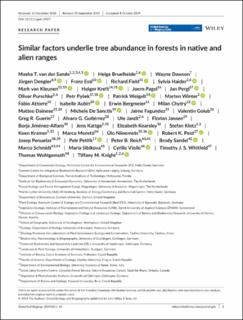Please use this identifier to cite or link to this item:
https://doi.org/10.21256/zhaw-18850| Publication type: | Article in scientific journal |
| Type of review: | Peer review (publication) |
| Title: | Similar factors underlie tree abundance in forests in native and alien ranges |
| Authors: | van der Sande, M.T. Bruelheide, H. Dawson, W. Dengler, Jürgen |
| et. al: | Yes |
| DOI: | 10.1111/geb.13027 10.21256/zhaw-18850 |
| Published in: | Global Ecology and Biogeography |
| Volume(Issue): | 29 |
| Issue: | 2 |
| Page(s): | 281 |
| Pages to: | 294 |
| Issue Date: | Feb-2020 |
| Publisher / Ed. Institution: | Wiley |
| ISSN: | 0960-7447 1466-8238 |
| Language: | English |
| Subjects: | Macroecology; Biological invasion |
| Subject (DDC): | 577: Ecology 580: Plants (Botany) |
| Abstract: | Aim: Alien plant species can cause severe ecological and economic problems, and therefore attract a lot of research interest in biogeography and related fields. To identify potential future invasive species, we need to better understand the mechanisms underlying the abundances of invasive tree species in their new ranges, and whether these mechanisms differ between their native and alien ranges. Here, we test two hypotheses: that greater relative abundance is promoted by (a) functional difference from locally co-occurring trees, and (b) higher values than locally co-occurring trees for traits linked to competitive ability. Location: Global. Time period: Recent. Major taxa studied: Trees. Methods: We combined three global plant databases: sPlot vegetation-plot database, TRY plant trait database and Global Naturalized Alien Flora (GloNAF) database. We used a hierarchical Bayesian linear regression model to assess the factors associated with variation in local abundance, and how these relationships vary between native and alien ranges and depend on species’ traits. Results: In both ranges, species reach highest abundance if they are functionally similar to co-occurring species, yet are taller and have higher seed mass and wood density than co-occurring species. Main conclusions: Our results suggest that light limitation leads to strong environmental and biotic filtering, and that it is advantageous to be taller and have denser wood. The striking similarities in abundance between native and alien ranges imply that information from tree species’ native ranges can be used to predict in which habitats introduced species may become dominant. |
| URI: | https://digitalcollection.zhaw.ch/handle/11475/18850 |
| Fulltext version: | Published version |
| License (according to publishing contract): | CC BY 4.0: Attribution 4.0 International |
| Departement: | Life Sciences and Facility Management |
| Organisational Unit: | Institute of Natural Resource Sciences (IUNR) |
| Appears in collections: | Publikationen Life Sciences und Facility Management |
Files in This Item:
| File | Description | Size | Format | |
|---|---|---|---|---|
| Sande_et_al-2019-Global_Ecology_and_Biogeography.pdf | 930.23 kB | Adobe PDF |  View/Open |
Show full item record
van der Sande, M. T., Bruelheide, H., Dawson, W., & Dengler, J. (2020). Similar factors underlie tree abundance in forests in native and alien ranges. Global Ecology and Biogeography, 29(2), 281–294. https://doi.org/10.1111/geb.13027
van der Sande, M.T. et al. (2020) ‘Similar factors underlie tree abundance in forests in native and alien ranges’, Global Ecology and Biogeography, 29(2), pp. 281–294. Available at: https://doi.org/10.1111/geb.13027.
M. T. van der Sande, H. Bruelheide, W. Dawson, and J. Dengler, “Similar factors underlie tree abundance in forests in native and alien ranges,” Global Ecology and Biogeography, vol. 29, no. 2, pp. 281–294, Feb. 2020, doi: 10.1111/geb.13027.
VAN DER SANDE, M.T., H. BRUELHEIDE, W. DAWSON und Jürgen DENGLER, 2020. Similar factors underlie tree abundance in forests in native and alien ranges. Global Ecology and Biogeography. Februar 2020. Bd. 29, Nr. 2, S. 281–294. DOI 10.1111/geb.13027
van der Sande, M.T., H. Bruelheide, W. Dawson, and Jürgen Dengler. 2020. “Similar Factors Underlie Tree Abundance in Forests in Native and Alien Ranges.” Global Ecology and Biogeography 29 (2): 281–94. https://doi.org/10.1111/geb.13027.
van der Sande, M. T., et al. “Similar Factors Underlie Tree Abundance in Forests in Native and Alien Ranges.” Global Ecology and Biogeography, vol. 29, no. 2, Feb. 2020, pp. 281–94, https://doi.org/10.1111/geb.13027.
Items in DSpace are protected by copyright, with all rights reserved, unless otherwise indicated.